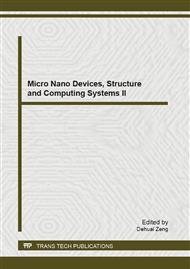p.98
p.103
p.109
p.113
p.119
p.125
p.130
p.136
p.145
Thermal Design and Analysis of VOX Microbolometer
Abstract:
In this paper, we analyze the bridge legs in which the largest deformation can be observed by conducting simulation via ANSYS tools and determine the membrane layer structure, which consists of one 0.1μm thick VOX thermal sensing layer and 7 other layers with thickness ratio 0.1μmSi3N4/0.3μmSiO2/0.1μmSi3N4/0.05μmNiCr/0.1μmSi3N4/0.3μmSiO2/0.1μmSi3N4. The stable and transient thermal simulation analysis of the microbridge is performed. From the stable thermal analysis of temperature field profile, the highest and lowest temperatures and the temperature heterogeneity of the bridge deck are 300.526K, 300.468K and 0.058K respectively. The thermal time constant 6.0ms is acquired from the transient thermal analysis, which can reach the requirement of 60fps frame rate. Moreover the joule heating effect is then examined, which has influence on temperature rise of bridge deck with 3V voltage applied between two legs. The highest temperature of bridge deck is 300.354K which is lower than 300.526K caused by thermal radiation. At last, the force simulation analysis of microbridge is performed, which is based on the forementioned thermal analysis, the largest deformation is 46.45nm, the largest equivalent stress is 2.503GPa.
Info:
Periodical:
Pages:
119-124
Citation:
Online since:
March 2013
Authors:
Price:
Сopyright:
© 2013 Trans Tech Publications Ltd. All Rights Reserved
Share:
Citation:


